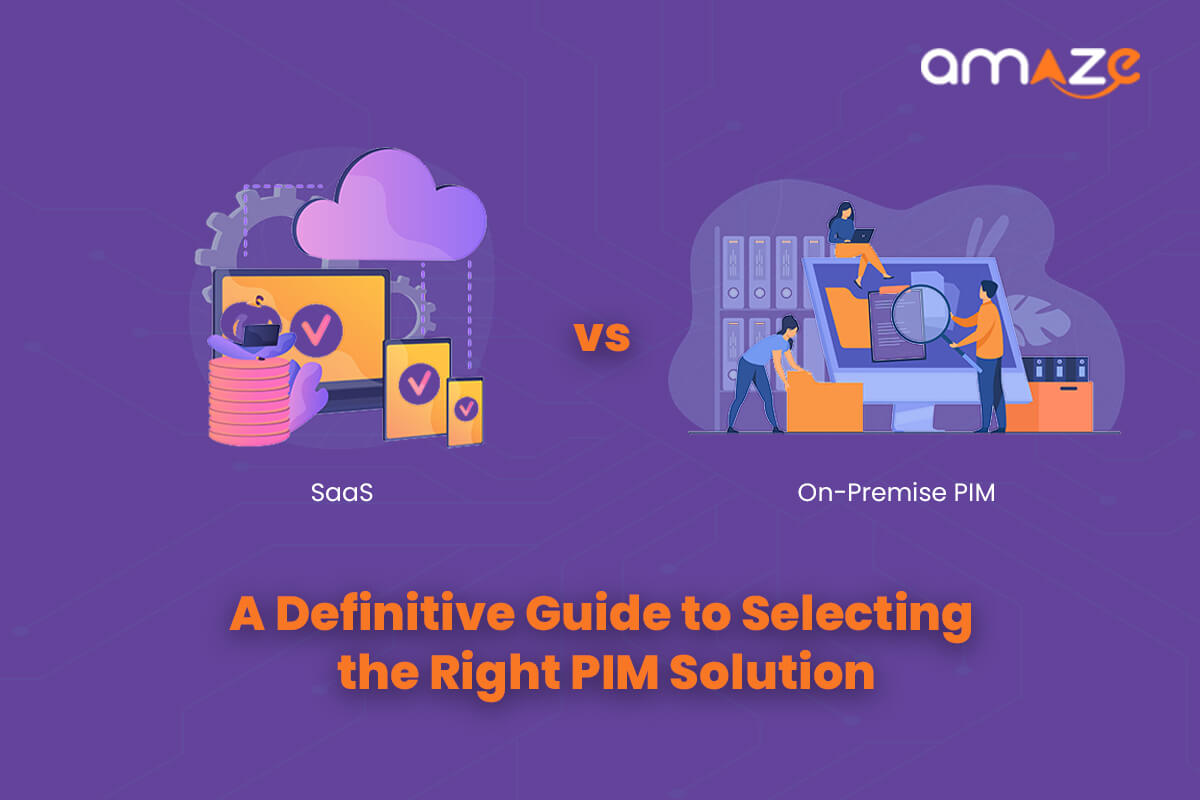SaaS vs. On-Premise PIM: A Definitive Guide to Selecting the Right PIM Solution

We explored more than a few reasons why product information management (PIM) is an essential tool for eCommerce success in our previous blog – 7 reasons to use a PIM as part of your digital commerce strategy. Whether it’s speed, scalability and data quality or customer retention and loyalty, PIM has ubiquitously grown as a foundational element for eCommerce success. This, however, is just one of the advantages it provides to digital commerce operations, the next-gen, native cloud PIM solutions have much more to offer compared to legacy on-premise PIM.
The next big question is whether to go the traditional route, with an on-premise PIM, or opt for a Software as a Service (SaaS), an avenue that many forward-looking businesses have already explored. The early adopters of SaaS are already up and running, and from the look of things, this pattern is only going one way: up. In fact, Gartner predicts that SaaS expenditure by end users will grow by close to $365 million in 2022. Share this as a Tweet
That being said, traditional on-premise systems for product information management (PIM) have, since long, delivered steady results. They give organizations complete control over infrastructure, platform and applications, and are known to be robust in terms of security. So how is it that an organization decides whether to go for an on-premise PIM or a SaaS?
How are SaaS and On-Premise PIM systems different?
The most telling difference between on-premise solutions and software as a service solutions (SaaS) is that, while on-prem solutions are hosted in-house, SaaS solutions are hosted by a third party on the cloud. What works best for your organization depends on a variety of factors including company culture, security requirements, business objectives and budget. At this level, the decision looks like a 50-50, but is there a clear winner in the SaaS vs. On-Premise tug of war? Let’s find out.
PIM PLATFORM COMPARISON – SaaS Vs On-Premise PIM
| Amaze PXM SaaS | On-Premise PIM | |
|---|---|---|
| Single Platform Solution | Yes, PIM + DAM + Syndication | No |
| Content Authoring | Deep | Basic |
| Digital Asset Management | Full DAM Functionality | Pre-built / No Custom Build |
| AI (Artificial Intelligence) | Fully Integrated | None |
| Cloud Infrastructure | Native Cloud | On-Premise / Some Cloud |
| Implementation & Onboarding | Weeks | Months |
| Integrations | On Demand | Standard |
| Pricing | Affordable | Expensive |
Cost Efficiency
Yes, we’re cutting right to the chase. Traditional on-prem solutions are known to cost a lot because organizations are required to purchase the required hardware and also factor in setup and implementation costs. While ongoing maintenance and recurring costs may seem to be low in terms of the solution itself, getting the most of on-premise PIMs requires organizations to foster IT infrastructure and manpower for maintenance and issue resolution. These costs tend to creep up with organizations attributing them directly to PIM costs, and hence operating under the false pretext of having made a “one-time investment”. And we’re not even getting started about costs for hardware updates that will pile up over the years.
YSaaS PIM services give businesses a chance to start small with low entry costs. Since the organization is virtually renting out the hardware and other services, there’s no need to shell out a big amount up-front. Again, with the right SaaS, organizations are not locked in to pay for features and functionalities they don’t need. All in all, the total cost of ownership (TCO) in SaaS is much lower than on-premise solutions and with higher benefits to reap from SaaS.
Faster Implementation
On-premise PIM implementation is a long and tedious process. It takes a whole lot of planning and execution, and more often than not, it’s a while before businesses can see the real benefits of the system. Even as implementation kicks off, complete deployment is never a reality until all aspects are tested and refined. Then again, as the name suggests, on-premise solutions limit access to company grounds.
SaaS PIM implementation is relatively simple and quick; almost instant in many business cases. Organizations can kick off right away, without having to wait for the setup of physical infrastructure, since the service is available straight off the internet. This also enables users to get started regardless of their location. In short, getting started with a SaaS PIM can be achieved within a matter of weeks, as compared to on-premise systems that may take months to setup.
Faster Implementation
On-premise PIM implementation is a long and tedious process. It takes a whole lot of planning and execution, and more often than not, it’s a while before businesses can see the real benefits of the system. Even as implementation kicks off, complete deployment is never a reality until all aspects are tested and refined. Then again, as the name suggests, on-premise solutions limit access to company grounds.
SaaS PIM implementation is relatively simple and quick; almost instant in many business cases. Organizations can kick off right away, without having to wait for the setup of physical infrastructure, since the service is available straight off the internet. This also enables users to get started regardless of their location. In short, getting started with a SaaS PIM can be achieved within a matter of weeks, as compared to on-premise systems that may take months to setup.
Percentage of SaaS in use, currently at 70%, is expect to grow to 85% by 2025 – BetterCloud
Upgrades, Customization & Flexibility
Upgrading on-premise solutions is usually an exhaustive project requiring extensive planning, and often includes heavy cost implications. Then again, large-scale upgrades may also include system downtime that affects business operations in a big way. The onus and accountability, once again, relies heavily on internal IT teams and any delay in the process can impact outcomes adversely.
From the SaaS point of view, vendors usually offer tiered plans that can be leveraged as and when required. Upgrades are ongoing and don’t require the business to stall operations for these upgrades to take effect. Out-of-the-box upgrades and updates mean that businesses don’t need to worry about the time and cost of developing from scratch. SaaS platforms are cognizant of varying business models, and hence, businesses don’t need to worry about rigid one-size-fits-all solutions.
In most cases, on-premise solutions are available in the form of large suites. Many of the features and functions on these suites are not useful to the business, but yet, since they are a part of the suite, you land up paying for it. On the other hand, since most SaaS software support headless architecture, it is easier and more cost effective to go with a modular solution.
Support & Maintenance
On-premise solutions make businesses the masters of their own fate; but not necessarily in a good way. These solutions leave businesses in charge of their own support, maintenance and upgrades. This requires them to have a highly skilled team of IT experts that can deal with everything from fixing bugs to disaster recovery and even security concerns – factors that are critical to well-rounded customer experience. While there is more control, there is also a great amount of risk.
SaaS solutions, on the other hand, take the hassle of support and maintenance out of the hands of the organization, and into the hands of the third-party provider. Since these vendors must offer bang for buck, they are obliged to handle disaster recovery, maintenance and upgrades with a best-in-market approach.
Scaling Up
Similar to the ‘upgrade and customization’ challenge with on-premise solutions, scaling up requires a whole lot of planning. Unexpected roadblocks, often times the kind that internal IT teams are not equipped to deal with, add to the complexity of the project. In other words, if businesses are looking to stay agile and nimble, on-premise solutions just don’t make the cut.
With SaaS solutions, there is always the option to upscale and add additional servers, bandwidth, licenses or storage without having to stall operations. Similarly, SaaS platforms make it equally easy to downscale features and services – just wait for the next renewal window and scale according to your requirements.
Compliance & Security
On-premise solutions require organizations to have dedicated personnel to keep an eye on the need for security updates and ever-evolving compliance standards. These personnel must have in-depth knowledge of the security and compliance aspect of the business and also possess the technical acumen to ensure that systems are up to speed.
Contrary to the initial popular belief (and fear), SaaS solutions are not riskier than on-premise solutions from either the security, or compliance standpoint. In fact, with a reliable SaaS platform, you can be rest assured that it is equipped with up-to-date, best-in-class security and compliance mechanisms to ensure protection of both, client’s data and also their own reputation. That said, it is imperative for companies to stay on top of security and compliance concerns, and ensure that their SaaS vendor is equally aware of them.
Similarly, businesses also get the added advantage of backup and recovery options with SaaS solutions. Once data is uploaded to the cloud, it is automatically backed up and made available for recovery when required. While on-premise solutions can offer these capabilities too, it comes at a rather high cost.
Future Readiness
SaaS gives companies the power of agility, flexibility and scalability, making it easier for them to adapt and evolve for the changing digital landscape. In addition to this, AI and ML are slowly but surely finding their way into the SaaS PIM playground. Given that these technologies are relatively new, finding them on on-premise PIM solutions is understandably challenging. Even if they are available here, we come back to the ‘upgrading and customizing’ problem, where you’ll land up paying much more for AI and ML on traditional monolithic platforms. On the other hand, AI and ML are available on SaaS platforms at a fraction of the cost, and more often than not, deeply embedded into the software solution.
If you’re curious about how to get your digital journey up and running with a SaaS PIM, or even looking to migrate from a legacy on-premise PIM to a cloud-based SaaS, try Amaze PXM. Blue Meteor’s Amaze PXM is industry’s first, AI-powered, cloud-native, single platform solution for PIM (Product Information Management), DAM (Digital Asset Management) and Syndication:
Related Articles
Recent Post
Categories





